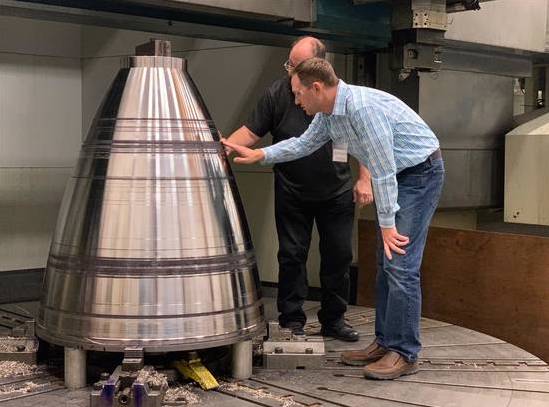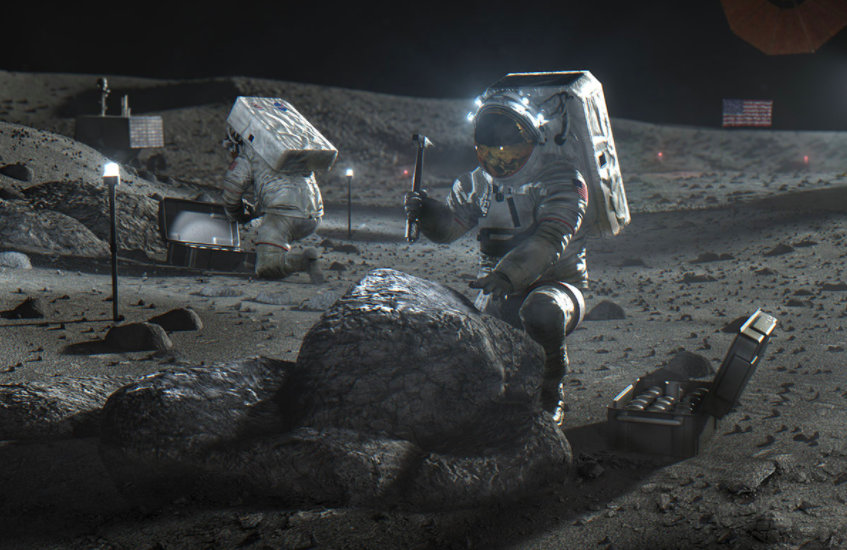NASA has developed 3D printed rocket engine components that could be used as part of the Artemis project to return astronauts to the Moon, and prepare for a future mission to Mars.
Through its Rapid Analysis and Manufacturing Propulsion Technology project (RAMPT), NASA has optimized a blown powder Directed Energy Deposition (DED) technique to fabricate several large-format parts. The advanced printing process has enabled NASA to significantly reduce the lead times and costs of producing complex engine components such as nozzles and combustion chambers.
“This technology advancement is significant, as it allows us to produce the most difficult and expensive rocket engine parts for a lower price tag than in the past,” said Drew Hope, Manager of NASA’s Game Changing Development Program, which funds RAMPT. “Further, it will allow companies within and outside the aerospace industry to do the same, and apply this manufacturing technology to the medical, transportation, and infrastructure industries.”
NASA’s enhanced DED-based 3D printing process
NASA established its RAMPT program to develop novel manufacturing technologies, with the overall aim of increasing the scale and performance of its thrust chamber assemblies. At present, the rocket chamber takes the longest time to produce, is the most expensive, and is the heaviest part of all those that make up NASA’s rocket engine systems.
Working with government and industry partners, RAMPT is not only reducing the engine’s cost, but developing an integrated specialty supply chain for materials, hardware and testing.
Collaborating with Auburn University, for instance, RAMPT is developing commercial 3D printing technologies alongside a number of manufacturing firms. Such partnerships not only allow RAMPT to share the costs associated with development, but to optimize advanced additive manufacturing for use within other industries.
Recently, RAMPT has made significant advances in the development of an enhanced DED 3D printing technique, which has enabled it to create numerous rocket parts. The printing method works by injecting metal powder into a laser-heated pool of molten metal (or its melt pool). Then, a print-head, composed of a blown powder nozzle and laser optics, is attached to a robot, which creates components in a layer-by-layer process.
Leveraging the emerging technology, NASA scientists were able to fabricate much larger pieces than previously possible, which are limited only by the size of the room in which they are created. The new DED process was also proven capable of create highly complex parts such as engine nozzles with internal coolant channels.

Rocket engine nozzles that feature internal cooling channels are advantageous, as they can run cryogenic propellant through their grooves, to help keep the device at safe temperatures. DED-printed mission critical parts also take less time to fabricate, and production costs are significantly reduced compared to those created using conventional manufacturing methods.
“It’s a challenging process to manufacture the nozzles traditionally, and it can take a very long time,” said Paul Gradl, RAMPT co-principal investigator at NASA’s Marshall Space Flight Center. “Blown powder DED additive manufacturing allows us to create very large-scale components with complex internal features that were not previously possible.”
NASA has deployed its new DED 3D printing process to produce one of the largest nozzles the organization has ever printed. Measuring 40 inches in diameter and standing 38 inches tall, the nozzle, featuring fully-integrated cooling channels, was fabricated in just 30 days. By comparison, using traditional welding techniques, the device would have taken a whole year to produce.
The RAMPT project’s success has gained the attention of NASA’s Space Launch System (SLS) rocket team, which is heavily involved in the Artemis space program. Now the SLS crew is planning to further invest in the enhanced DED technology, in order to certify the process for spaceflight. In future, the SLS team is aiming to work with RAMPT to build and evaluate a channel-cooled nozzle that is up to 5 feet in diameter, and almost 7 feet tall.
“Producing channel wall nozzles and other components using this new type of additive manufacturing could enable us to make SLS engines at the scale required with a reduced schedule and reduced cost,” concluded Johnny Heflin, Liquid Engines Office manager for the SLS Program.

NASA’s additive aerospace industry partnerships
NASA has frequently partnered with commercial firms as a means of creating enhanced rocket parts, and advancing the adoption of 3D printing technology across the aviation industry.
Working alongside satellite launch company Virgin Orbit in May last year, NASA produced a working 3D printed rocket engine combustion chamber. The copper component successfully completed a test-firing at the Marshall Space Flight Center (MSFC), delivering up to 2,000 pounds of thrust.
In a collaboration with aerospace manufacturer Boeing, NASA used 3D printing to insulate the more vulnerable parts of its Artemis deep space rocket. The joint team designed, tested and 3D printed a precise mold that protected the space around the rocket’s thrust assembly.
NASA’s Jet Propulsion Laboratory (JPL) also used American software firm Autodesk’s generative design technology to build an interplanetary lander. Autodesk’s software was deployed to reduce the weight of the 3D printed parts used to produce the vehicle, allowing it to carry more space exploration tools in the process.
Nominations for the 2020 3D Printing Industry Awards are still open, let us know who is leading the industry now.
The fourth edition of the 3D Printing Industry Awards Trophy Design Competition is now underway. Enter your design for the chance to win a CraftBot Flow 3D printer.
To stay up to date with the latest 3D printing news, don’t forget to subscribe to the 3D Printing Industry newsletter or follow us on Twitter or liking our page on Facebook.
Are you looking for a job in the additive manufacturing industry? Visit 3D Printing Jobs for a selection of roles in the industry.
Featured image shows a DED 3D printed nozzle, the largest that NASA has fabricated in its history. Photo via NASA.



